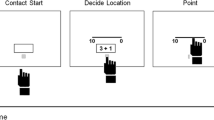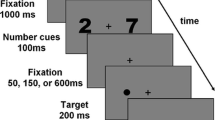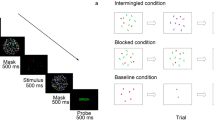Abstract
There is some evidence that human subjects preferentially select small numbers when asked to sample numbers from large intervals “at random”. A retrospective analysis of single digit frequencies in 16 independent experiments with the Mental Dice Task (generation of digits 1–6 during 1 min) confirmed the occurrence of small-number biases (SNBs) in 488 healthy subjects. A subset of these experiments suggested a spatial nature of this bias in the sense of a “leftward” shift along the number line. First, individual SNBs were correlated with leftward deviations in a number line bisection task (but unrelated to the bisection of physical lines). Second, in 20 men, the magnitude of SNBs significantly correlated with leftward attentional biases in the judgment of chimeric faces. Finally, cognitive activation of the right hemisphere enhanced SNBs in 20 different men, while left hemisphere activation reduced them. Together, these findings provide support for a spatial component in random number generation. Specifically, they allow an interpretation of SNBs in terms of “pseudoneglect in number space.” We recommend the use of random digit generation for future explorations of spatial-attentional asymmetries in numerical processing and discuss methodological issues relevant to prospective designs.


Similar content being viewed by others
Abbreviations
- RNG:
-
Random number generation
- MDT:
-
Mental dice task
- SNB:
-
Small-number bias
- LB:
-
Line bisection
- LVF:
-
Left visual field
- RVF:
-
Right visual field
References
Baird JC, Noma E (1975) Psychophysical study of numbers I. Generation of numerical responses. Psychol Res Psychol Forsch 37:281–297
Banks WP, Coleman MJ (1981) Two subjective scales of number. Percept Psychophys 29:95–105
Banks WP, Hill DK (1974) Apparent magnitude of number scaled by random production. J Exp Psychol 102:353–376
Borod JC, Haywood CS, Koff E (1997) Neuropsychological aspects of facial asymmetry during emotional expression: a review of the normal adult literature. Neuropsychol Rev 7:41–60
Bowers D, Heilman KM (1980) Pseudoneglect—effects of hemispace on a tactile line bisection task. Neuropsychologia 18:491–498
Brugger P (1997) Variables that influence the generation of random sequences: an update. Percept Mot Skills 84:627–661
Brugger P, Milicevic A, Regard M, Cook ND (1993) Random-number generation and the menstrual-cycle—preliminary evidence for a premenstrual alteration of frontal-lobe functioning. Percept Mot Skills 77:915–921
Brugger P, Monsch AU, Salmon DP, Butters N (1996) Random number generation in dementia of the Alzheimer type: a test of frontal executive functions. Neuropsychologia 34:97–103
Brugger P, Pietzsch S, Weidmann G, Biro P, Alon E (1995) Stroop-type interference in random-number generation. Psychol Rep 77:387–390
Bub D, Gum T (1990) Psychlab. In: McGill Technical Manuals, McGill University, Montreal
Bull R, Benson PJ (2006) Digit ratio (2D: 4D) and the spatial representation of magnitude. Horm Behav 50:194–199
Bultitude JH, Aimola Davies AM (2006) Putting attention on the line: investigating the activation-orientation hypothesis of pseudoneglect. Neuropsychologia 44:1849–1858
Cahill L (2006) Why sex matters for neuroscience. Nat Rev Neurosci 7:477–484
Calabria M, Rossetti Y (2005) Interference between number processing and line bisection: a methodology. Neuropsychologia 43:779–783
Campbell JJ (2000) Neuropsychiatric assessment. In: Coffey CE, Cummings JL (eds) Textbook of Geriatric Neuropsychiatry. American Psychiatric Publishing, Washington, DC, pp 109–124
Casarotti M, Michielin M, Zorzi M, Umilta C (2007) Temporal order judgment reveals how number magnitude affects visuospatial attention. Cognition 102:101–117
Daniels C, Witt K, Wolff S, Jansen O, Deuschl G (2003) Rate dependency of the human cortical network subserving executive functions during generation of random number series—a functional magnetic resonance imaging study. Neurosci Lett 345:25–28
de Hevia MD, Girelli L, Vallar G (2006) Numbers and space: a cognitive illusion? Exp Brain Res 168:254–264
Dehaene S (1997) The number sense. How the mind creates mathematics. Oxford University Press, Oxford
Dehaene S, Bossini S, Giraux P (1993) The mental representation of parity and number magnitude. J Exp Psychol Gen 122:371–396
Dehaene S, Mehler J (1992) Cross-linguistic regularities in the frequency of number words. Cognition 43:1–29
Dehaene S, Piazza M, Pinel P, Cohen L (2003) Three parietal circuits for number processing. Cogn Neuropsychol 20:487–506
Diekamp B, Regolin L, Gunturkun O, Vallortigara G (2005) A left-sided visuospatial bias in birds. Curr Biol 15:R372–R373
Doricchi F, Guariglia P, Gasparini M, Tomaiuolo F (2005) Dissociation between physical and mental number line bisection in right hemisphere brain damage. Nat Neurosci 8:1663–1665
Fias W, Fischer MH (2005) Spatial representation of numbers. In: Campbell JID (eds) Handbook of mathematical cognition. Psychology Press, New York, pp 43–54
Fischer MH (2001) Number processing induces spatial performance biases. Neurology 57:822–826
Fischer MH (2003) Spatial representations in number processing—evidence from a pointing task. Vis Cogn 10:493–508
Fischer MH, Castel AD, Dodd MD, Pratt J (2003) Perceiving numbers causes spatial shifts of attention. Nat Neurosci 6:555–556
Fischer MH, Warlop N, Hill RL, Fias W (2004) Oculomotor bias induced by number perception. Exp Psychol 51:91–97
Gitelman DR, Nobre AC, Parrish TB, LaBar KS, Kim YH, Meyer JR, Mesulam M (1999) A large-scale distributed network for covert spatial attention: further anatomical delineation based on stringent behavioural and cognitive controls. Brain 122:1093–1106
Gobel SM, Calabria M, Farne A, Rossetti Y (2006) Parietal rTMS distorts the mental number line: Simulating “spatial” neglect in healthy subjects. Neuropsychologia 44:860–868
Hubbard EM, Piazza M, Pinel P, Dehaene S (2005) Interactions between number and space in parietal cortex. Nat Rev Neurosci 6:435–448
Jahanshahi M, Dirnberger G, Fuller R, Frith CD (2000) The role of the dorsolateral prefrontal cortex in random number generation: a study with positron emission tomography. Neuroimage 12:713–725
Jewell G, McCourt ME (2000) Pseudoneglect: a review and meta-analysis of performance factors in line bisection tasks. Neuropsychologia 38:93–110
Kinsbourne M, Cook J (1971) Generalized and lateralized effects of concurrent verbalization on a unimanual skill. Q J Exp Psychol 23:341–345
Knoch D, Brugger P, Regard M (2005) Suppressing versus releasing a habit: frequency-dependent effects of prefrontal transcranial magnetic stimulation. Cereb Cortex 15:885–887
Lee GP, Struss E, Loring DW, McCloskey L, Haworth JM, Lehman RAW (1997) Sensitivity of figural fluency on the five-point test to focal neurological dysfunction. Clin Neuropsychol 11:59–68
Luh KE, Gooding DC (1999) Perceptual biases in psychosis-prone individuals. J Abnorm Psychol 108:283–289
Luh KE, Rueckert LM, Levy J (1991) Perceptual asymmetries for free viewing of several types of chimeric stimuli. Brain Cogn 16:83–103
McCourt ME, Jewell G (1999) Visuospatial attention in line bisection: stimulus modulation of pseudoneglect. Neuropsychologia 37:843–855
Moyer RS, Landauer TK (1967) Time required for judgements of numerical inequality. Nature 215:1519–1520
Nicholls MER, Roberts GR (2002) Can free-viewing perceptual asymmetries be explained by scanning, pre-motor or attentional biases? Cortex 38:113–136
Noma E, Baird JC (1975) Psychophysical study of numbers II. Theoretical models of number generation. Psychol Res Psychol Forsch 38:81–95
Nuerk HC, Wood G, Willmes K (2005) The universal SNARC effect—the association between number magnitude and space is amodal. Exp Psychol 52:187–194
Oliveri M, Rausei V, Koch G, Torriero S, Turriziani P, Caltagirone C (2004) Overestimation of numerical distances in the left side of space. Neurology 63:2139–2141
Priftis K, Zorzi M, Meneghello F, Marenzi R, Umilta C (2006) Explicit versus implicit processing of representational space in neglect: dissociations in accessing the mental number line. J Cogn Neurosci 18:680–688
Rath G (1966) Randomization by humans. Am J Psychol 79:97–103
Regard M, Strauss E, Knapp P (1982) Children’s production on verbal and non-verbal fluency tasks. Percept Mot Skills 55:839–844
Restle F (1970) Speed of adding and comparing numbers. J Exp Psychol 83:274–278
Reuter-Lorenz PA, Kinsbourne M, Moscovitch M (1990) Hemispheric control of spatial attention. Brain Cogn 12:240–266
Rossetti Y, Jacquin-Courtois S, Rode G, Ota H, Michel C, Boisson D (2004) Does action make the link between number and space representation? Visuo-manual adaptation improves number bisection in unilateral neglect. Psychol Sci 15:426–430
Rueckert L, Deravanesian A, Baboorian D, Lacalamita A, Repplinger M (2002) Pseudoneglect and the cross-over effect. Neuropsychologia 40:162–173
Schueli H, Henn V, Brugger P (1999) Vestibular stimulation affects dichotic lexical decision performance. Neuropsychologia 37:653–659
Schütze H, Bürki P, Brugger P, Koller E (1993) Neuropsychological reactions at moderate altitude. In: Sutton J, Houston C, Coates G (eds) Hypoxia and molecular medicine. Queen City Printers Inc., Burlington, p 313
Schwarz W, Keus IM (2004) Moving the eyes along the mental number line: comparing SNARC effects with saccadic and manual responses. Percept Psychophys 66:651–664
Seron X, Pesenti M, Noel MP, Deloche G, Cornet JA (1992) Images of numbers, or when 98 is upper left and 6 sky blue. Cognition 44:159–196
Shuren J, Hartley T, Heilman KM (1998) The effects of rotation on spatial attention. Neuropsychiatry Neuropsychol Behav Neurol 11:72–75
Tranel D, Damasio H, Denburg NL, Bechara A (2005) Does gender play a role in functional asymmetry of ventromedial prefrontal cortex? Brain 128:2872–2881
Vuilleumier P, Ortigue S, Brugger P (2004) The number space and neglect. Cortex 40:399–410
Zorzi M, Priftis K, Meneghello F, Marenzi R, Umilta C (2006) The spatial representation of numerical and non-numerical sequences: evidence from neglect. Neuropsychologia 44:1061–1067
Zorzi M, Priftis K, Umilta C (2002) Brain damage: neglect disrupts the mental number line. Nature 417:138–139
Acknowledgments
We thank the investigators of the original experiments on RNG for having administered the Mental Dice Task. We also acknowledge financial support by the Betty and David Koetser foundation (to PB).
Author information
Authors and Affiliations
Corresponding author
Rights and permissions
About this article
Cite this article
Loetscher, T., Brugger, P. Exploring number space by random digit generation. Exp Brain Res 180, 655–665 (2007). https://doi.org/10.1007/s00221-007-0889-0
Received:
Accepted:
Published:
Issue Date:
DOI: https://doi.org/10.1007/s00221-007-0889-0




